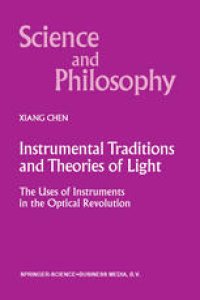
Ebook: Instrumental Traditions and Theories of Light: The Uses of Instruments in the Optical Revolution
Author: Xiang Chen (auth.)
- Tags: History, Philosophy of Science, History and Philosophical Foundations of Physics, Interdisciplinary Studies
- Series: Science and Philosophy 9
- Year: 2000
- Publisher: Springer Netherlands
- Edition: 1
- Language: English
- pdf
An analysis of the optical revolution in the context of early 19th century Britain. Far from merely involving the replacement of one optical theory by another, the revolution also involved substantial changes in instruments and the practices that surrounded them. People's judgements about classification, explanation and evaluation were affected by the way they used such optical instruments as spectroscopes, telescopes, polarisers, photometers, gratings, prisms and apertures. There were two instrumental traditions in this historical period, each of which nurtured a body of practice that exemplified how optical instruments should be operated, and especially how the eye should be used. These traditions functioned just like paradigms, shaping perspectives and even world views.
Readership: Scholars and graduate students in the history of science, history of instrument, philosophy of science and science studies. Can also be used as a textbook in graduate courses on 19th century physics.
An analysis of the optical revolution in the context of early 19th century Britain. Far from merely involving the replacement of one optical theory by another, the revolution also involved substantial changes in instruments and the practices that surrounded them. People's judgements about classification, explanation and evaluation were affected by the way they used such optical instruments as spectroscopes, telescopes, polarisers, photometers, gratings, prisms and apertures. There were two instrumental traditions in this historical period, each of which nurtured a body of practice that exemplified how optical instruments should be operated, and especially how the eye should be used. These traditions functioned just like paradigms, shaping perspectives and even world views.
Readership: Scholars and graduate students in the history of science, history of instrument, philosophy of science and science studies. Can also be used as a textbook in graduate courses on 19th century physics.
An analysis of the optical revolution in the context of early 19th century Britain. Far from merely involving the replacement of one optical theory by another, the revolution also involved substantial changes in instruments and the practices that surrounded them. People's judgements about classification, explanation and evaluation were affected by the way they used such optical instruments as spectroscopes, telescopes, polarisers, photometers, gratings, prisms and apertures. There were two instrumental traditions in this historical period, each of which nurtured a body of practice that exemplified how optical instruments should be operated, and especially how the eye should be used. These traditions functioned just like paradigms, shaping perspectives and even world views.
Readership: Scholars and graduate students in the history of science, history of instrument, philosophy of science and science studies. Can also be used as a textbook in graduate courses on 19th century physics.
Content:
Front Matter....Pages i-xxiii
Comparisons of Explanatory Power....Pages 1-12
Explanatory Power and Classification....Pages 13-26
Classification and the Use of Instruments....Pages 27-46
The Dispute over Dispersion....Pages 47-67
The Discovery of the “Polarity of Light”....Pages 69-86
The Measurements of the Intensity of Light....Pages 87-107
Instrumental Traditions....Pages 109-128
The Geometric Tradition and the Wave Theory of Light....Pages 129-146
The Visual Tradition and the Closure of the Optical Revolution....Pages 147-166
Back Matter....Pages 167-212
An analysis of the optical revolution in the context of early 19th century Britain. Far from merely involving the replacement of one optical theory by another, the revolution also involved substantial changes in instruments and the practices that surrounded them. People's judgements about classification, explanation and evaluation were affected by the way they used such optical instruments as spectroscopes, telescopes, polarisers, photometers, gratings, prisms and apertures. There were two instrumental traditions in this historical period, each of which nurtured a body of practice that exemplified how optical instruments should be operated, and especially how the eye should be used. These traditions functioned just like paradigms, shaping perspectives and even world views.
Readership: Scholars and graduate students in the history of science, history of instrument, philosophy of science and science studies. Can also be used as a textbook in graduate courses on 19th century physics.
Content:
Front Matter....Pages i-xxiii
Comparisons of Explanatory Power....Pages 1-12
Explanatory Power and Classification....Pages 13-26
Classification and the Use of Instruments....Pages 27-46
The Dispute over Dispersion....Pages 47-67
The Discovery of the “Polarity of Light”....Pages 69-86
The Measurements of the Intensity of Light....Pages 87-107
Instrumental Traditions....Pages 109-128
The Geometric Tradition and the Wave Theory of Light....Pages 129-146
The Visual Tradition and the Closure of the Optical Revolution....Pages 147-166
Back Matter....Pages 167-212
....